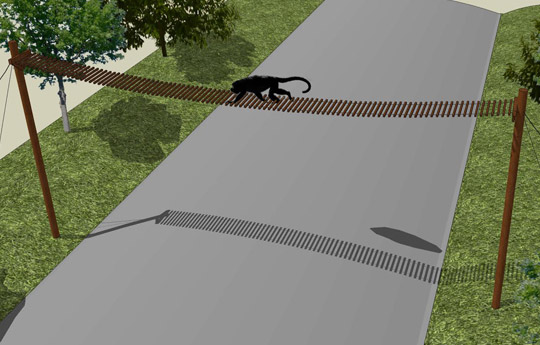CONSERVATION
There will be fauna bridges to protect monkey populations
Together with high school students, CONICET scientists designed a project to preserve arboreal animals.
A research group at the Estación Biológica Corrientes –EBCo- [Biological Station of Corrientes] of the National Scientific and Technical Research Council (CONICET) worked with two high school students to design fauna bridges to be placed in the Ruta Provincial Nº 8, in the province of Corrientes. The project aims to conserve monkey populations in the area and other arboreal species that are affected by traffic.
“As we began to find dead monkeys, we noticed that, at specific places, when they go down, they are hit by cars or attacked by dogs in the neighbourhood. After the fragmentation of the forests, the monkeys had to change the places where they used to move and even the way they did it, like going down or use the power lines”, Martin Kowalewski, CONICET associate researcher and director of the Estación Biológica Corrientes, comments as regards the beginning of the project.
The station is located in San Cayetano, in Riachuelo, 20 kilometres from the city of Corrientes. In recent years, this area has experienced a strong urbanization for the new houses and industries that have been built there. As a result, the traffic in provincial routes increased, thus changing the ecosystem.
“I noticed this project for monkeys when I travelled to Mexico and Brazil. During that trip, I met a Mexican colleague who was building some bridges in the south of his country and I said to myself ‘we are going to do the same’”, the researcher commented. Due to time and the extension of the environment, the group decided to involve two high schools: San Cayetano – which is located in the area – and the Instituto Pío XI, a private institute of the city of Corrientes.
We are planning to build five bridges with wooden posts and the walkway with steel wire and pallets, which are waste materials of the forest industry donated by the surrounding companies. “The design was developed with the kids and with the help of some of their parents, who are engineers and architects, we consulted the Iguazú plans. After submitting everything in Vialidad Provincial, the project was approved and then we sought all the necessary permissions. Shortly after that we received the support of Municipalidad de Riachuelo [local town council].Therefore, Corrientes is going to be the first province to undertake a project of this kind”, Kowalewski commented.
The students attended workshops on environmental conservation, under the guidance of Viridiana González, CONICET associate professional and responsible for outreach and education to the environment Station. The idea of the project was designed there and when it was finished, the team looked for the donations for the construction of the bridges – which are still seeking for support-, and so on. For its part, the town council will provide the necessary labour.
“It is important to highlight that the kids understand that the project is not only for the monkeys and other animals – crab-eating raccoon, weasels, among others- to use the bridge, we are also linking two different realities for the conservation problem, which is the advance on the resources and how that affects the society. Our goal is to foster awareness on the protection of natural resources”, the researcher explained.
For its part, the San Cayetano Highschool designed another kind of bridge made of tacuara canes and garbage bags as knotted ropes. This bridge is less resistant than the one created for the route so, in March; it will be placed inside the Estación Biológica Corrientes [Corrientes Biological Station] as a way of realization of the first stage of activities with the schools.
Research and conservation of diversity
The Estación Biológica Corrientes [Corrientes Biological Station] is under the scope of the ‘Bernardino Rivadavia’ Argentine Museum of Natural Sciences – CABA-, and therefore the National Scientific and Technical Research Council [CONICET]. It has a hundred hectares and its director is Martin Kowalewski, CONICET associate researcher, who works there with other technicians and fellows.
Regarding biodiversity, the Station has more than one hundred and seventy species of birds recorded, and in the case of large mammals, there are primates, foxes, maned wolf, otters, guazunchos, yaguarundíes, capybaras and also alligators. The space has a variety of environments, which could be observed on the way to the Riachuelo River: mountains, esteros [wetlands], large lakes, palms and a three kilometres of coast river with about five hundred meters of beach.
“There is a project of the Ministry of Science and Technology of Argentina to to link the scientific environment with eco-tourism. There is a project that includes the creation of a provincial nature reserve with a scientific institution built at the centre. The place will be prepared to receive people, with sanitation, multipurpose room, new paths with self-guided planked walkways”, Kowalewski said.
There are few places in the country and in the world with this concept of scientific institution inside a protected area, what makes the site more valuable. The studies performed here focused on primates, such as infectious diseases, friendship, hormonal profiles and reproductive strategies, juvenile behaviour in monkeys. In only six years there have been several theses studies, and there are currently four more in progress, which is an important production.
